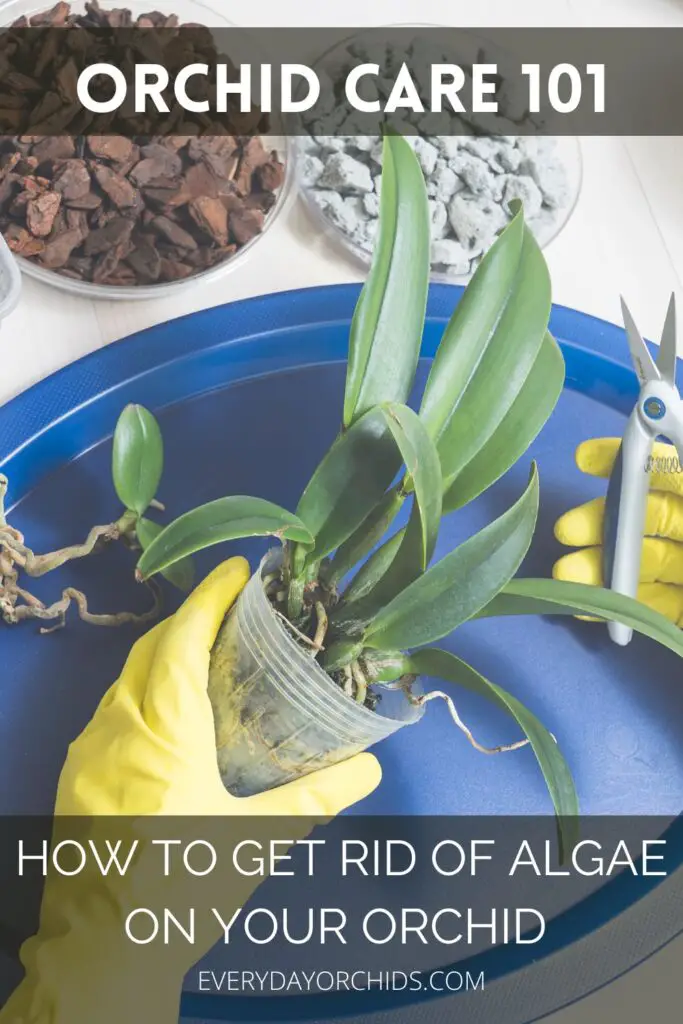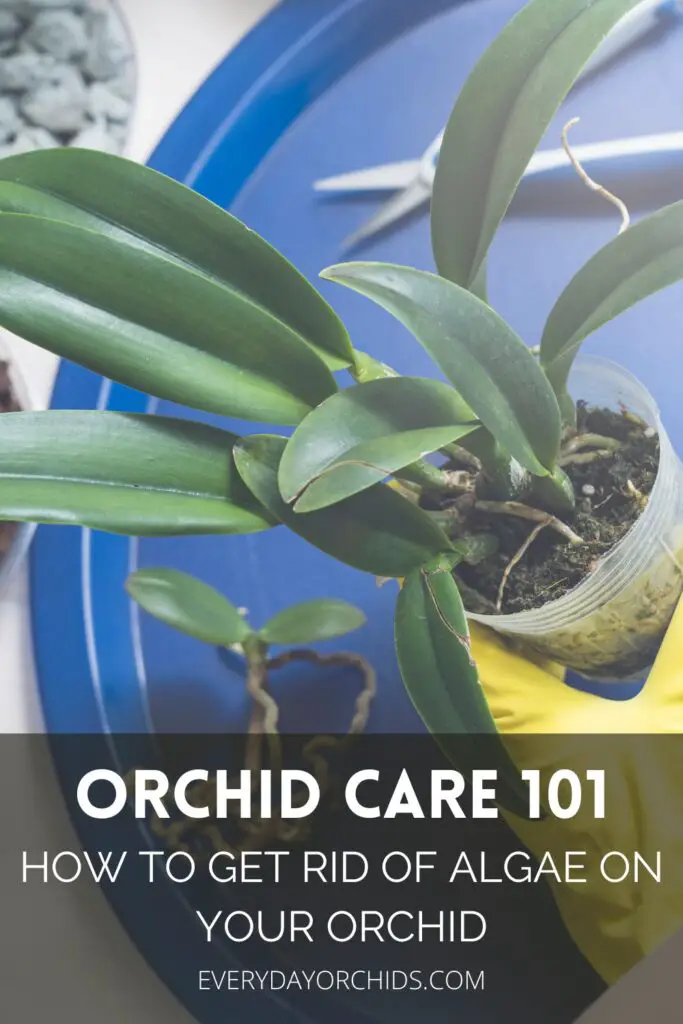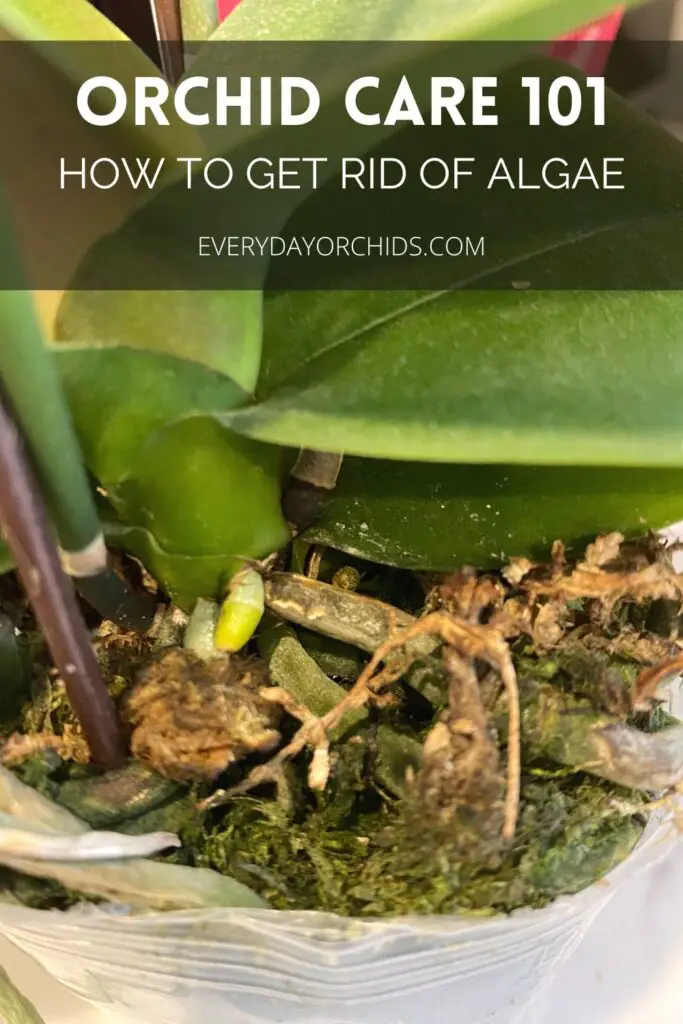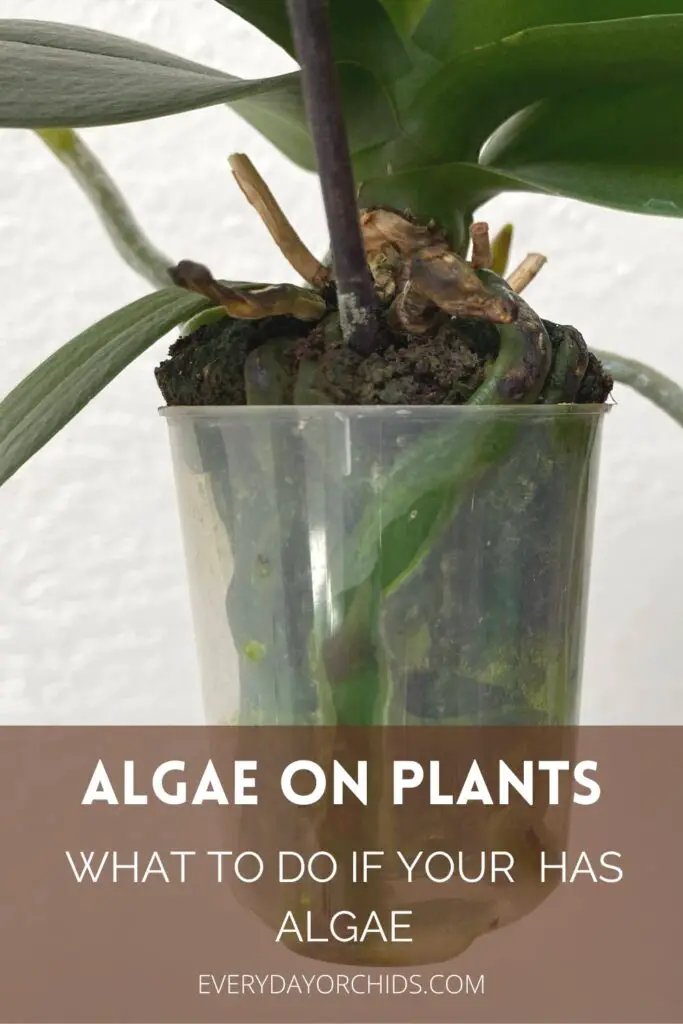If you are wondering how to get rid of algae on your orchids and other houseplants, you’ve come to the right place. Algae generally presents as a green, slimy film covering the inside of your potting container, potting media, and at times, the roots.
Algae is not entirely uncommon. It grows quickly under the right conditions and can affect orchids or houseplants, particularly those grown in semi-hydroponics or full-hydroponics. The question is, how do you get rid of algae once you find it on your plant?

Depending on where the algae is located and how much there is, you may be able to clean it off your plants using simple methods, such as water or algaecide. If the algae is more widespread, then you will have to resort to more involved methods. These include repotting and sterilization of the potting container, cleaning the roots and changing out the potting media.
In this article, I’ll go over each of the different ways you can get rid of algae on your plants in more detail. These methods can be applied to orchids and other types of houseplants potted in plastic pots or grown in semi-hydroponics or hydroponics situations.
In terms of orchid care, you’ll also learn how to remove algae from orchid roots and orchid pots without harming your orchid. Once that’s done, you’ll learn how to prevent algae from growing on or around your plants in the future. Keep reading to learn more.
Please note that these links are affiliate links and as an Amazon Associate, I earn from qualifying purchases. Purchases made through affiliate links in this post may generate commissions at no additional cost to you. Use this link for a discounted Amazon Prime trial. Thank you for your support!
Table of Contents
How To Get Rid Of Algae On Orchid Roots
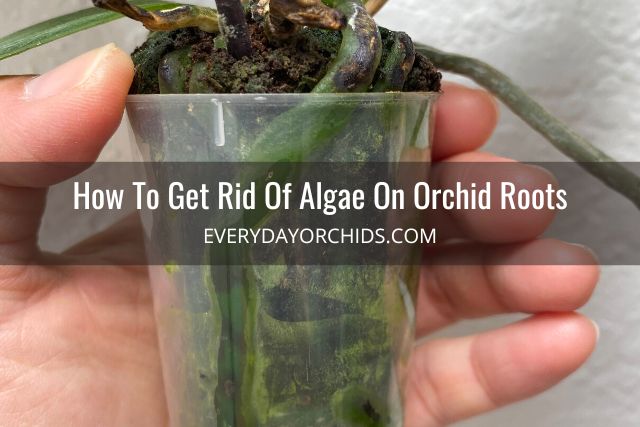
Wondering whether or not you need to worry about the algae on your houseplant? You may be asking because algae has started to grow on your orchid’s pot and roots, or in your hydroponics set-up.
In most cases, a little bit of algae on the roots or pot won’t hurt the plant. This goes if you have an orchid and you are worried about this delicate plant, or if you have a houseplant potted in semi-hydro. I went over this in more detail in my article about why algae grows on orchids.
On the other hand, if you have excessive amounts of algae covering the plant’s roots, that is a problem, especially for orchids.
In extreme cases, the algae can prevent the roots from properly absorbing nutrients and water. This effectively suffocates them. If you have substantial amounts of algae on your orchids or houseplants, you will need to take steps to get rid of the algae.
There are several methods you can use to get rid of algae on your orchid’s roots, or any plant’s roots, for that matter. You can use algaecide, water pressure, or change the growing conditions around your orchids and plants to deter algae growth.
Some people do nothing or use hydrogen peroxide to deal with the algae. However, I’ll explain below why you wouldn’t want to choose either of those options.
First, let’s talk about what you can do to stop or minimize algae growth on orchid roots and other houseplants. In no particular order, I’ll address using algaecide, water, or changing the plant’s growing conditions to tackle the algae.
Algaecide
One of the popular options to address algae growth are algaecides such as Physan20. You can try to use a diluted algaecide to try to rid the orchid of the algae. The jury is out on this one. Some orchid growers recommend this method, while others don’t find it that effective.
I personally would not jump to this method first or use it as the sole treatment method. You can use it but do so in combination with the other methods listed below.
Remember, after you kill off the algae, you’ll still need to get rid of it somehow. Leaving dead algae on your orchid will lead to rot, decay and other problems.
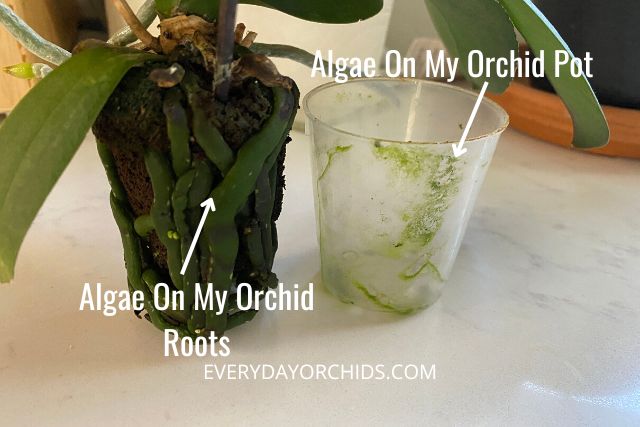
Hose Down Or Wash The Roots
If you have a lot of algae on your orchid roots, another method is to use water pressure and forcibly dislodge the algae from the orchid roots.
For this method, you can take a high pressure hose and spray down your orchid roots outside. This would only work if your orchids are unpotted with their roots exposed, or have long, aerial roots like Vanda orchids. Spraying down the roots may work to dislodge a portion of the algae.
If this doesn’t work, put on some waterproof gloves and gently wash the roots under running water. Carefully rub the algae off the roots with your fingers. Allow the water to wash the algae particles away. If your orchid is potted, simply unpot it first and then clean the algae off the roots using this method.
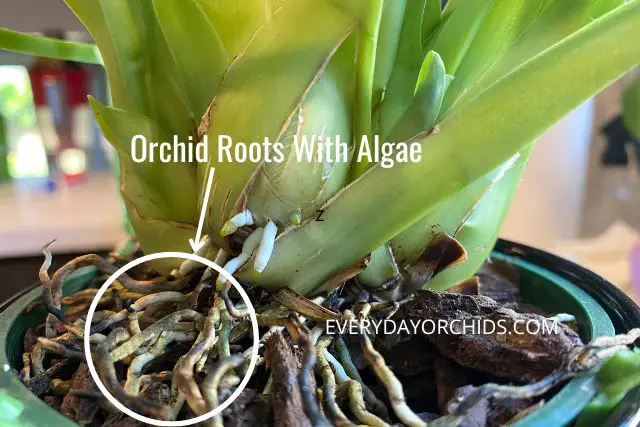
Adjust The Orchid’s Growing Conditions
Another option you can use in conjunction with either of the two methods above is to make a change in your orchid’s or houseplant’s growing conditions.
Algae thrives in an environment rich in nutrients, moisture and light. Adjust the growing conditions to make it less favorable to the algae. This is what I would do.
If your orchid or houseplant is in a clear pot, then double pot it into an opaque outer pot.
If the algae overgrowth is due to excessive fertilization, then stop fertilizing your orchid or houseplant for a short period. Alternatively, reduce the amount of fertilizer used either by diluting it further or fertilizing less often.
Do some trial and error to see what works best, keeping in mind the conditions that are best for algae growth. Try to minimize those conditions without harming your orchid. It will take some time, but if you do it right, the algae will eventually die.
Clean Off Dead Algae
Whether you use algaecide or make adjustments to the growing environment, if you do it right, algae will start to die over time. This dead algae will dry up and begin flaking off your orchid roots.
When you see this happening, give your orchid a thorough rinse. Wash away the dead algae and let the water run through the pot.
If you are growing your orchid in a semi-hydroponic set-up, then change out the water. This will remove the dead algae from the water and allow you to replace the old water with fresh, clean water.
I would also recommend switching out the algae-covered LECA pebbles for clean, sterilized ones at this time as well.
Do Nothing
Now, let’s talk about what you DON’T want to do, starting with the “do nothing” route. Doing nothing is obviously the easiest choice. In this scenario, you go about your daily life and hope that the algae eventually dies on its own.
This is clearly the most passive route and one I wouldn’t recommend. For one thing, algae grows quickly. If nothing is done to change the growing conditions or hinder it’s growth, it will continue to grow unfettered. Soon, the algae could start to line the potting media, potting container and even cover the roots of the plant.
As time goes on, the overgrowth of algae will eventually start to suffocate the orchid roots and compete for nutrients. The algae will block any light from coming into the potting container. Older algae will start to die off, begin to decompose and give off a foul odor.
If you continue to do nothing, the decomposing organic material will encourage bacterial and fungal infections to take hold in your plant.
So, whether you do it now or later, you’ll need to address the algae.
Hydrogen Peroxide And Algae
Another thing you DON’T want to do is use hydrogen peroxide to try and kill the algae.
You may have heard that hydrogen peroxide can be used to kill algae, but this is actually not the case.
Whatever you do, don’t pour hydrogen peroxide on your orchid’s roots in an attempt to kill the algae.
Not only will this not kill the algae, but it will damage your orchid’s delicate roots. Just don’t do it.
In fact, studies have been done to see if there is any effect of 3% hydrogen peroxide on algae. Researchers found that 3% hydrogen peroxide did not kill the algae but did damage root health. In addition, hydrogen peroxide concentrations of 6% and 12% caused root death and affected the overall health of the orchid.
The conclusion of the study was that instead of using hydrogen peroxide to treat algae, orchid growers should instead focus on adjusting their growing conditions and watering practices.
How To Get Rid Of Algae On Sphagnum Moss
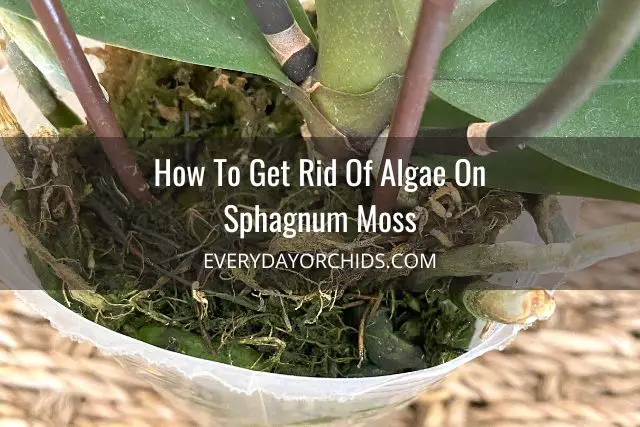
Now, let’s talk about orchid potting media, in particular, sphagnum moss. If you grow your orchids in sphagnum moss, you may eventually find a layer of algae growing along the top of the sphagnum moss.
Algae growth happens more often for orchids grown in sphagnum moss than in traditional orchid bark.
This is because of the algae spores. Algae spores can hide in the sphagnum moss.
The chances of this are higher if the moss wasn’t heat-sterilized before packaging or use. The light, constant moisture, and nutrients in the moss environment provide algae spores with a suitable habitat to grow.
So, what do you do if you have algae on your orchid’s sphagnum moss? If it is just a little bit and not spreading, you could just ignore it.
Case in point: I have a few orchids potted in sphagnum moss with a little bit of algae growing along the moss at the top of the pot. As far as I can tell, the algae has not spread. The orchids are growing well and the algae is not harming the orchid.
Get Rid Of Algae On Potted Orchids
However, in other cases, you may want to pull out the sphagnum moss that is covered in algae and replace it with new moss. This would be the case if the algae is extensive and interfering with your orchid’s health.
If this is the case and your orchid is potted in moss, you will need to unpot it and remove all the sphagnum moss.
Clean the roots well and prune off any dead or rotted roots. Repot the orchid in new sphagnum moss. Ideally, this moss would have been heat-treated and sterilized to kill off the algae spores.
Get Rid Of Algae On Mounted Orchids
On the other hand, if your orchid is mounted on a wooden board such as this one, the process of removing algae will be a lot more involved.
You will need to replace the sphagnum moss with new moss, as above. To do this, you will need to unwrap the mounting wire that is keeping the orchid and moss attached to the mount.
Then, remove the old moss covered in algae. Replace it with fresh sphagnum moss. Afterwards, secure the orchid and potting media to the mount with new mounting wire.
Alternatively, if you want to avoid unwrapping your mounted orchid or unpotting your orchid, you can try a shortcut method using tweezers. This way, you may not need to unwrap the mounting wire from the mount, saving you both time and work.
To use this shortcut method, use tweezers to remove the sphagnum moss with algae on it. Then sterilize the tweezers and carefully place new sphagnum moss in the gaps.
Sterilizing the tweezers is key. You don’t want to contaminate the new moss with algae spores from the old moss.
How To Get Rid Of Algae On Pots And Potting Media
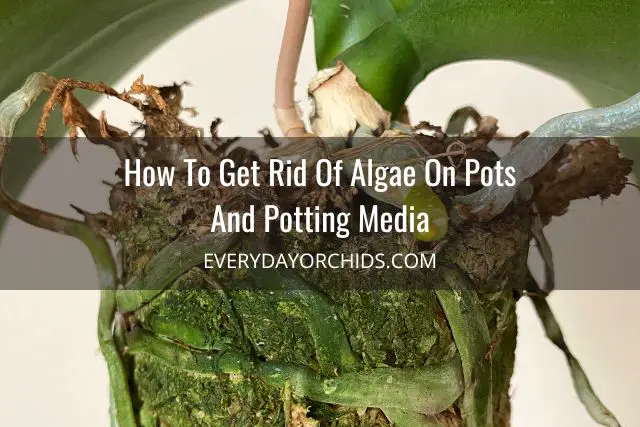
Sometimes you’ll find algae growing on both the pots and potting media. This can be the case if you have an orchid growing in a clear plastic pot.
It can also happen with plants and orchids growing in semi-hydroponics or hydroponics. The chances of this happening are higher if the outer container used is clear.
Either way, the method you use to get rid of the algae depends on where it is and whether the plant is single potted or double potted.
Get Rid Of Algae On The Outer Pot
First, I’ll talk about what to do if the plant is double potted.
In this scenario, the plant itself is in a removable inner pot, usually seen in semi-hydroponics or hydroponics situations, and the outer pot or container is clear.
If you find a layer of algae only on the outer pot, getting rid of the algae is easy. Simply take out the inner orchid pot with the orchid or houseplant. Set it aside. Using a sponge or a brush, scrub the algae off the outer pot.
I also recommend sterilizing the outer pot or container before using it again. To do this, soak the outer pot in a 10% bleach solution (1 part bleach to 9 parts water) for a minimum of 10 minutes. Doing so will sanitize the outer pot and help kill off any lingering algae spores.
After enough time has passed, rinse the outer pot or container with clean water. Place your orchid or plant’s inner pot back into the outer pot or container. If you were using this for a semi-hydroponics or hydroponics set-up, fill it back up with water as you normally would.
Get Rid Of Algae On The Inner Pot
If the algae is in the pot that the orchid or plant is currently potted in, you will need to first carefully unpot your orchid. Set the plant to the side and clean off any algae on the orchid roots as needed.
Next, thoroughly clean and sanitize the inner pot. Go ahead and clean the outer pot as well. Use an old toothbrush to scrub off the algae from the pots.
Let both pots soak in a bucket of 10% bleach water for at least 10 minutes. This will sterilize the pots and kill off any lingering organisms. Afterwards, rinse off the pots using clean water.
If you are using LECA pebbles for your semi-hydroponics set-up, algae can spread to these as well. Scrub them well and sterilize the LECA in a 10% bleach solution too.
Some growers also boil the LECA or place them in a pressure cooker to sanitize them. However you choose to sanitize the LECA pebbles is up to you, but you will need to do this before reusing them.
Once the pots (and LECA pebbles) have been sterilized and cleaned of algae, you can use them to repot the orchid.
When repotting, be sure to use new orchid potting media or sterilized LECA pebbles. Don’t reuse old potting media or uncleaned LECA, since they may be harboring algae spores or other pathogens.
Repotting an orchid can be very stressful for the orchid and can be a lot of work for you. For this reason, I don’t recommend unnecessarily unpotting the orchid just to clean the pot and remove small amounts of algae. Only do this if the algae is extensive and interfering with your orchid’s growth and health. Remember, algae is not necessarily harmful for orchids.
Get Rid Of Algae On The Potting Media
If you do have algae on the orchid pot and potting media, then it is more worthwhile to unpot the orchid and change out the potting media.
To do this, follow this guide to repotting orchids. The steps you will take will be the same: unpot the orchid, dispose of the old potting media, prune off any dead roots, and repot the orchid using new potting media.
Get Rid Of Algae And Semi-Hydroponics
If you are growing your orchids or other houseplants in semi-hydroponics, you may find a lot of algae on the inside of the container and the LECA pebbles. The process for getting rid of algae in semi-hydroponics set-ups will be similar.
Remove your orchid carefully from the container. Sanitize the LECA pebbles and potting containers as I outlined above. Repot the orchid or houseplant into a new, clean vessel. Be sure to use clean, sterilized LECA pebbles.
How To Prevent Algae From Coming Back
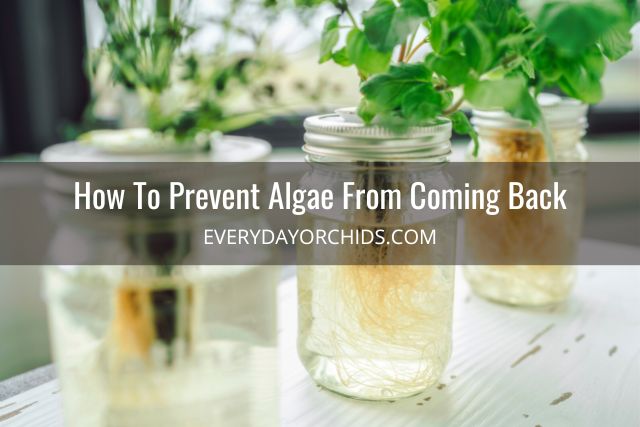
Once you’ve gone through the effort and hassle of cleaning and removing algae from your orchid’s roots, pot and potting media, you probably are wondering how you can prevent the algae from coming back.
There are several things you can do to prevent algae from growing in your orchid pots and semi-hydroponics and hydroponics set-up.
Adjust The Growing Conditions
The best way to prevent algae growth in your orchids and other plants is to manage the growing conditions. Algae grows best in warm, humid, moist conditions with nutrients and light.
If you grow your orchids and other plants in a greenhouse, you may find that algae is growing on the greenhouse walls.
When this happens, try lowering your humidity settings and allow for some airflow. This will reduce the amount of moisture available and decrease the chance that algae will grow.
During cooler months, decrease your watering frequency. This will minimize the chances that your orchid’s potting media stays damp for too long. Again, this will reduce the amount of available moisture and decrease opportunities for algae growth.
In addition, during the cooler, darker winter months, many of us turn to artificial lighting to supplement care for our orchids and other plants. Use of artificial lighting may encourage algae growth, as it provides both light and warmth.
To prevent this, be mindful of how long you leave your artificial lights on as well as how often you water your plants. If you start to see algae growth, try to adjust the lighting duration along with the other growing conditions.
Change The Water Frequently
If you are growing your orchids in semi-hydroponics, I recommend using an inner net pot housed in an outer container.
With this set-up, be sure to routinely flush the inner net pot with plain water. Regularly change out the water in the reservoir as well and use fresh water.
If you are using only one container to hold both your LECA pebbles and plant, then about once a month or so, carefully change out the water for fresh water. Try to do this without disturbing your plant too much.
You may need to hold your hand over the top of the container to keep the LECA and plant in place and let the old water flow through your fingers. Fill with clean water and pour it back out carefully in the same way. This is your “rinse.” Afterwards, use fresh water to refill the container with water up to your plant’s usual “fill” line.
Double Pot Your Orchids And Other Plants
If your orchid is housed in a clear pot, try double potting it. This method applies to both semi-hydroponics and traditional orchid growing in pots.
Place the clear plastic orchid pot in a ceramic outer pot. This will help block the light from reaching the orchid roots, and therefore, help prevent algae from growing.
Double potting the orchid also has the added benefit of providing stability and a solid base for your orchid plant. It will be less likely to tip over, especially during blooming season, when orchids tend to get more top-heavy.
Sterilize The Potting Media
Another tip to prevent algae growth on sphagnum moss is to boil or soak the sphagnum moss in very hot water before using it.
The high temperature will kill algae spores and help sterilize the sphagnum moss to a certain degree.
This goes without saying, but let the sphagnum moss cool completely before using it to pot your orchids and other plants.
Don’t Over-Fertilize
Over-fertilization, combined with the right growing conditions for algae, can lead to excessive algae growth.
To avoid this, don’t over-fertilize your orchid and houseplants. Follow this Everyday Orchids guide to learn how to fertilize your orchids. Remember, orchids prefer weak fertilization!
Final Thoughts
I’ve provided you several methods for how to get rid of algae on orchid roots, the potting media, and orchid pots. These methods will also apply to other houseplants that may have algae growth on the roots, pots and potting media as well.
I’ve also talked about how to deal with algae in a semi-hydroponic situation and with mounted orchids. Keep in mind that a little algae typically doesn’t harm orchids or other plants. However, left alone, it has the potential to quickly grow and get out of hand.
Remember, an ounce of prevention is always worth a pound of cure. To save yourself from dealing with algae in the first place, try to manage your orchids’ and other plants’ growing conditions. Use the Everyday Orchids tips listed above for preventing algae growth in orchids. As always, happy orchid growing!
